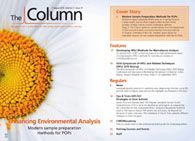Investigating Yeast Products in Sparkling Wine Production
A team of researchers in Spain has examined the use of commercial yeast products in the production of white and rosé sparkling wines.
A team of researchers in Spain has examined the use of commercial yeast products in the production of white and rosé sparkling wines.1 Using a range of analytical techniques, including gas chromatography–mass spectrometry (GC–MS) and high performance liquid chromatography (HPLC), the team examined four yeast autolysates to find out how they affect the chemical composition, foam, and sensory properties of sparkling wines aged on lees for 9 months.
Photo Credit: Maciej Toporowicz, NYC/Getty Images

During the production of wine, mannoproteins - highly glycosylated proteoglycans made up of mannose, glucose, and proteins - are released via yeast autolysis. These mannoproteins can have positive effects on the wine, such as an improvement in aroma and a reduction in bitterness. Traditionally the best sparkling wines can take many months to ferment to the perfect quality. The longer the process takes, the higher the associated production costs and the greater the risk of microbiological and organoleptic alterations. To speed up this process commercial yeast products rich in mannoproteins have been developed. The effect of these products on still wines has been extensively studied, and they have been found to improve the quality characteristics of the wine. However, very few studies have examined the effect on sparkling wines.
All of the wine used in the study was produced following the traditional (champenoise) method. The team used GC–MS to determine the monosaccharide composition of the dry yeast products. The percentage of mannose in the four yeast products varied between 53% and 86%; the percentage of glucose was between 14% and 47%. HPLC was used to analyze phenolic compounds and amino acid and biogenic amine content. The foaming properties of the sparkling wine were evaluated according to the Mosalux procedure. By comparing the control and the sparkling wines, the team found that the addition of the yeast products did not affect the foam quality of the wines or the phenolic compound content in any significant way. In fact, the yeast product with the highest mannoprotein content actually enhanced the volatile composition and the subsequent fruity aroma in some of the sparkling wines. - K.M.
Reference
- Silvia Pérez-Magariño, Leticia Martínez-Lapuente, Marta Bueno-Herrera, Miriam Ortega-Heras, Zenaida Guadalupe, and Belén Ayestarán, Journal of Agricultural and Food Chemistry 63(23), 5670–5681 (2015).

New Study Reviews Chromatography Methods for Flavonoid Analysis
April 21st 2025Flavonoids are widely used metabolites that carry out various functions in different industries, such as food and cosmetics. Detecting, separating, and quantifying them in fruit species can be a complicated process.
Analytical Challenges in Measuring Migration from Food Contact Materials
November 2nd 2015Food contact materials contain low molecular weight additives and processing aids which can migrate into foods leading to trace levels of contamination. Food safety is ensured through regulations, comprising compositional controls and migration limits, which present a significant analytical challenge to the food industry to ensure compliance and demonstrate due diligence. Of the various analytical approaches, LC-MS/MS has proved to be an essential tool in monitoring migration of target compounds into foods, and more sophisticated approaches such as LC-high resolution MS (Orbitrap) are being increasingly used for untargeted analysis to monitor non-intentionally added substances. This podcast will provide an overview to this area, illustrated with various applications showing current approaches being employed.

.png&w=3840&q=75)

.png&w=3840&q=75)



.png&w=3840&q=75)



.png&w=3840&q=75)







